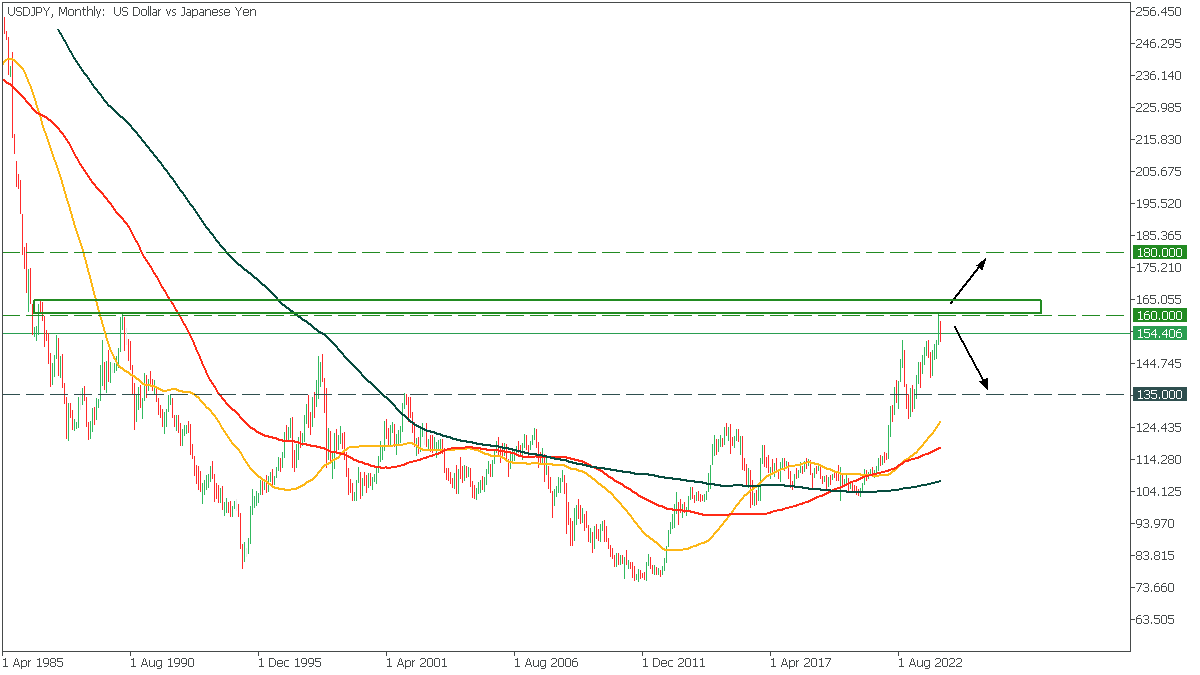In recent months, the Japanese yen has depreciated significantly against major currencies, especially the US dollar. Since the beginning of 2024, the yen has weakened to levels not seen in recent years and has reached thirty-year lows.
In this article, FBS financial market analysts will look at the reasons for this trend, what the Bank of Japan is doing to improve the situation, how the rest of the world is reacting, and what the Japanese currency may face in the near future.
Why is the Yen falling?
The depreciation of the Japanese yen can be explained by a combination of domestic and international factors that put downward pressure on its value.
The main domestic factor is Japan's continued commitment to ultra-loose monetary policy. Unlike global central banks such as the US Federal Reserve, which raises interest rates to fight inflation, the Bank of Japan (BoJ) maintains low interest rates and significant asset purchase programs. Even though the BoJ has abolished negative interest rates, the situation has persisted. This divergence in monetary policy has made the yen less attractive than currencies in other major economies where investors can realize higher returns due to higher interest rates.
The external strengthening of the US dollar significantly impacted the yen's decline. The dollar strengthened against most currencies, not just the yen, driven by US interest rates rising and remaining at 4.50% to combat inflation, starkly contrasting Japan's looser approach to monetary policy. As of the end of April 2024, the yen had weakened to nearly 160 per US dollar, a marked decline from the beginning.
Japan's shift from a traditionally favorable trade balance to a deficit has further impacted the yen's value. This shift to a trade deficit, where a country imports more than it exports, has been exacerbated by rising global energy prices, as Japan relies heavily on imports. This increase in imports requires more active conversion of the yen into foreign currency, which puts additional downward pressure on its value.
Investor sentiment also played a decisive role in the yen's depreciation. Due to lingering concerns about Japan's prolonged deflation and demographic issues, including a shrinking working-age population, investors are generally bearish on the yen. These bearish sentiments are exacerbated by speculative trading, with traders betting against the yen in anticipation of further depreciation, reinforcing the downward trend.
The Bank of Japan's stance and international reactions
Not long ago, the Bank of Japan (BoJ) was the latest to remove negative interest rates, marking the first interest rate hike in 17 years. This turnaround aims to normalize monetary policy in response to sustained inflationary pressures and signs of a strengthening economy, signaling a shift to potentially more aggressive monetary management. Although the rate hike is a clear departure from the ultra-accommodative policies that have guided Japan's monetary policy for many years, the Bank of Japan continues to undertake quantitative easing measures, albeit with a more cautious approach in the new environment. These measures are intended to provide liquidity and support economic activity. Still, they come with heightened risks, such as a potential increase in unrealized losses on bonds due to higher interest rates, which could affect the profitability of financial institutions.
Internationally, the reaction was cautiously optimistic, with markets taking the rate hike as a sign of confidence in the Japanese economy's prospects for recovery. However, the global financial community remains wary of this change's implications on international capital flows, especially in emerging markets with significant Japanese investment.
Speculation about possible Bank of Japan intervention in the foreign exchange market persists, especially given the yen's historical volatility and the central bank's previous interventions to stabilize or regulate its value. According to data analysis and expert forecasts, on May 1, 2024, the Bank of Japan directed about 3.5 trillion yen ($22.5 billion) to intervene in the foreign exchange market to support the yen's exchange rate.
Although the BOJ has not confirmed any direct intervention in the market following its recent policy shift, it has already taken measures to curb excessive volatility or unwanted movements in the yen exchange rate when they threaten economic stability. This strategic turn of the Bank of Japan shows its already familiar policy of responding to changing economic conditions aimed at balancing stimulating economic growth and containing inflationary pressures.
Therefore, the picture remains uncertain despite the Bank of Japan's steps to improve the yen's position.
Consequences and future
Historically, a weakening yen increases the competitiveness of Japanese exports as Japanese goods become cheaper for foreign buyers. Major industries such as automobiles and electronics benefit from increased sales abroad, which can support industrial activity and employment in Japan. However, the rising cost of imported raw materials could erode these gains, especially as commodity prices rise globally.
The yen depreciation also contributes to inflation by increasing the cost of imports, particularly energy and food, which Japan imports in large quantities. As of 2024, inflation in Japan is rising, albeit at a lower rate than in some other advanced economies.
Economists and market analysts make different predictions about the yen exchange rate. Some believe the yen could stabilize or even strengthen if the Bank of Japan moves to tighten monetary policy or if global economic conditions change (e.g., inflationary pressures in the US and Europe subside). However, others predict further exchange rate weakening as long as Japan's economic fundamentals - such as demographic challenges and dependence on energy imports - remain intact.
Experts predict that without significant economic reforms or changes in global market dynamics, the yen could continue to experience downward pressure. Conversely, any signs of a change in the Bank of Japan's tightening policy could quickly change the market sentiment and strengthen the yen.
USD/JPY, monthly timeframe
In the Monthly timeframe, USDJPY reached the 1990 high it has held for the last 34 years. Despite the Bank of Japan's interventions, the Fed keeping the key rate unchanged, and the bullish trend, the price may move in two directions.
-
If the price breaks the resistance of 160.00, we can expect further growth with the target of 180.00.
-
Otherwise, the rebound will drop USDJPY to the support at 135.00.
Conclusion
In conclusion, the situation of the Japanese yen reflects the broader challenges facing national economies in a globalized market. The Bank of Japan's recent policy adjustments represent a key response to these challenges, aimed at stabilizing and potentially strengthening the yen in a fluctuating global economy. However, it is still unclear whether these actions are sufficient and what further steps the US Fed will take. In these circumstances, it is worthwhile to carefully react to the reports of both Japan and the US, as they will influence the movement of the yen in the near future.
About FBS
FBS is a licensed global broker with over 15 years of experience and more than 90 international awards. FBS is steadily developing as one of the market’s most trusted brokers, with its traders numbering more than 27,000,000 and its partners exceeding 700,000 around the globe. The annual trading volume of FBS clients is over $8.9 trillion. FBS is also the Official Partner of Leicester City Football Club.
This is a sponsored post. The opinions expressed in this article are those of the author and do not necessarily reflect the views of FXStreet. FXStreet has not verified the accuracy or basis-in-fact of any claim or statement made by any independent author. You should be aware of all the risks associated with trading and seek advice from an independent financial advisor if you have any doubts.
This post is written and submitted by FBS Markets for informational purposes only. In no way shall it be interpreted or construed to create any warranties of any kind, including an offer to buy or sell any currencies or other instruments. The views and ideas shared in this post are deemed reliable and based on the most up-to-date and trustworthy sources. However, the company does not take any responsibility for accuracy and completeness of the information, and the views expressed in the post may be subject to change without prior notice.
Recommended Content
Editors’ Picks

Gold races toward $3,150, at record highs amid tariff woes
Gold price stretches its record-setting rally toward $3,150 in European trading on Monday. The bullion continues to capitalize on safe-haven flows amid intesifying global tariff war fears. US economic concerns weigh on the US Dollar and Treasury yields, aiding the Gold price upsurge.

EUR/USD holds steady below 1.0850 ahead of German inflation data
EUR/USD is holding steady below 1.0850 in early Europe on Monday. The pair draws some support from a broadly weaker US Dollar but buyers stay cautious ahead of Germany's prelim inflation data and Trump's reciprocal tariff announcement.

GBP/USD posts small gains near 1.2950 amid tariff woes
GBP/USD keeps the green near 1.2950 in the European morning on Monday. Concerns that US President Donald Trump's tariffs will ignite inflation and dampen economic growth weigh on the US Dollar and act as a tailwind for the pair.

Seven Fundamentals for the Week: “Liberation Day” tariffs and Nonfarm Payrolls to rock markets Premium
United States President Donald Trump is set to announce tariffs in the middle of the week; but reports, rumors, and counter-measures will likely dominate the headline. It is also a busy week on the economic data front, with a full buildup to the Nonfarm Payrolls (NFP) data for March.

US: Trump's 'Liberation day' – What to expect?
Trump has so far enacted tariff changes that have lifted the trade-weighted average tariff rate on all US imports by around 5.5-6.0%-points. While re-rerouting of trade will decrease the effectiveness of tariffs over time, the current level is already close to the highest since the second world war.

The Best brokers to trade EUR/USD
SPONSORED Discover the top brokers for trading EUR/USD in 2025. Our list features brokers with competitive spreads, fast execution, and powerful platforms. Whether you're a beginner or an expert, find the right partner to navigate the dynamic Forex market.

